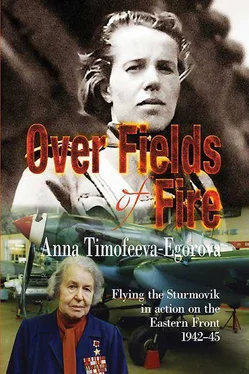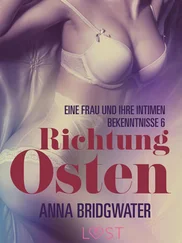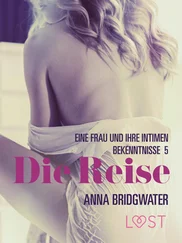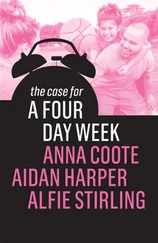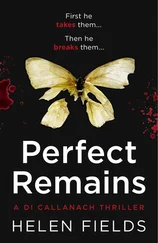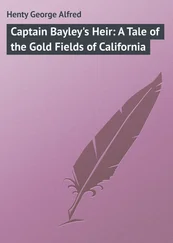I’d been told that once when only 6 operable machines were left in the regiment, an order had arrived to destroy a river crossing near the stanitsa Nikolayevskaya on the Don. They had to send all machines into the air and Major Kerov led them on the combat mission. The crossing was protected so well that there was hardly any chance of the group returning successfully. However, Kerov managed to cheat the enemy: he came at the target from the rear, smashed it and made it home with his whole group. His plane was towed from the airstrip by a tractor. They told me that Kerov walked alongside the Sturmovik riddled with shell splinters and supported it by a wing console as if it were a wounded friend.
“Soukhoroukov, Pashkov, Frolov…” The regiment commander called the pilots’ surnames looking along the line. “Egorova”, I heard my surname. “Strakhov, Tishchenko, Groudnyak, Sokolov, Zinoviev, Podynenogin…” And each of us took three steps forward from the line.
The regimental commander Kozin included just 19 pilots in the group — three squadron commanders, all the flight commanders and the senior pilots with combat experience. Soon after that we were met by the Front Commander I. E. Petrov and the commander of the 4th Aerial Army General K.A. Vershinin.
“You, comrades, have a task simple in terms of planning but very hard in terms of implementation”, the Front Commander addressed us, adjusting his pince-nez and stuttering slightly. “Our troops are to break through the Fascist defence’s Blue Line. But first of all we have to camouflage the advancing troops — to set up a smoke screen. You will do that.” General Petrov looked at me carefully and I actually clenched my shoulders — I thought he was going to ask: “What’s a woman doing here?” But the commander’s gaze slipped onto other pilots standing by the scale model of the Blue Line — and my spirits lifted.
The General went on to say the smoke screen would have to be set up on time and accurately so as to blind the enemy, to close his eyes for the time our infantry needed in order to capture the main defensive line’s trenches. The General clearly defined the direction and time for converging on the target, and then General Vershinin told us how to carry out the mission. We were to fly without aerial gunners, just above the ground and besides that without bombs, rockets or machine-guns in the rear cockpit, and the cannons and machine-guns were not to be loaded at all! Instead of bombs we would have cylinders of ‘smoke gas’ on the bomb racks. This gas, reacting with air, would form the smoke screen.
“The most complicated thing is that you are not allowed to manoeuvre”, General Vershinin leaned over the map. “Look here, 7 kilometres in a straight line with no manoeuvring, and at an extremely low altitude. Do you understand why you’re not allowed to manoeuvre?”
“We’ll get a discontinuous screen instead of a solid one”, one of the flyers said.
“A discontinuous one will mean the attack will break down somewhere”, Petrov commented, stroking his rust-coloured moustache. “That’s why the screen must be such that no searchlight beam breaks through it — solid, straight as a ruler!”
“This is what you’ll do”, Vershinin went on. “Once you see that the one flying ahead of you has put smoke out, count three seconds and press the triggers. Manoeuvring will mean wrecking the mission. But you’ll be flying over fire, under fire, amidst fire… It remains only to wish you good luck and a happy return…”
Bidding farewell General Vershinin invited: “If any of you has changed his mind — feel free to refuse. It’s your right. We want those to make this flight, who firmly believe that they will complete the mission and definitely make it home.”
None of us responded to the General’s invitation…
On 26 May, when the Eastern sky had just begun to grow pink, we headed to the aerodrome in a ton-and-a-half truck. Michael Nikolaevich Kozin, always joyful and affable, was very gloomy. He was either angry that they hadn’t allowed him to fly, or was worried about us. And the pilots? What kind of mood were we in before such an important take-off? I looked at them and saw Grisha Rzhevskiy romping with a kitten — his new mascot-playmate who didn’t want to sit in his bosom under the leather fur-lined jacket. My brother Egor was fond of animals too. Mum used to find, hidden under the kitchen table or barricaded under beds, kittens and puppies with saucers of milk. Having eaten they would begin to mew or bark desperately, and mum would become angry and threaten to belt Egor, but could never bring herself to. The lad had grown up, joined the armed forces and war had broken out. My brother Egor didn’t come back home. He was killed in action…
Kolya Pakhomov was singing his favourite song:
“You, young Cossack girl, stand by the wicker fence,
Before the sunrise see me off to the war…”
Tolya Yugrov excitedly said something to Valentin Vakhramov, and both laughed like children, holding on each other: as if nobody would have to throw himself into a firestorm in just a minute or two… Misha Berdashkevich’s blue eyes smiled at something. There were so many scorch scars on his naturally handsome face! Maybe he was recalling his escape from a hospital to his regiment in a hospital gown? Tasets, an ethnic Greek, stood pensively. Most likely he was thinking over again how to approach a target, is it efficient to do a circle and shift towards your own territory if Fascist fighters attack? Tasets is our ‘great theorist’ but also a good practical man as well.
Our 3rd Squadron commander Semyon Andrianov was hugging a colleague — a squadron commander — with one arm, and Boris Strakhov with the other one. All three were silently staring at the expanse of the Kuban Steppe, revived after the long winter. The twenty-year-old comesks always tried to seem respectable, putting on strict airs. Adrianov even procured a pipe and walked without taking it out of his mouth. He would move it a little to the corner of his mouth during a conversation, but in his eyes there was so much youthful fervour in his eyes, so many sparks ready to spray those around him! We knew that Semyon Andrianov was born in a steel worker’s family in Nizhniy Tagil. There he graduated from school and the aeroclub and from there he joined the Perm pilot school. An ordinary biography for a pilot… We knew that Semyon had wife and a daughter. He’d been in our regiment since April 1941 and now he was a squadron commander. His deputy was Philipp Pashkov. He was a gentleman, and at the moment he was carefully protecting me from the jolts of the bumps in the road while the truck carried us to our fighting machines. He would often tell me about his native town of Penza, his mother, sisters and father — a disabled war veteran who died when Philipp was only three years old.
“When the war is over, let’s go to Penza, stanishnitsa 119 119 Translator’s note — a common Cossack address to a female from the same stanitsa .
. I’ll show you the museum estates of Radishev and Belinskiy 120 120 Translator’s note — prominent Russian 19th Century democrats.
, Lermontov’s famous Tarkhany estate. You know, Alexander Ivanovich Kouprin 121 121 Translator’s note — a famous Russian writer in the late 19th — early 20th centuries.
is one of us Penza people too, from Narovchatov. And what forests we have! So many mushrooms and berries!” Filipp drawled rocking from side to side. Like any dedicated mushroom-picker he exaggerated: “You can come across glades in our forest where you can mow the saffron milk caps with a scythe. My mum cooks them so well! You’ll come, won’t you?”
Читать дальше
